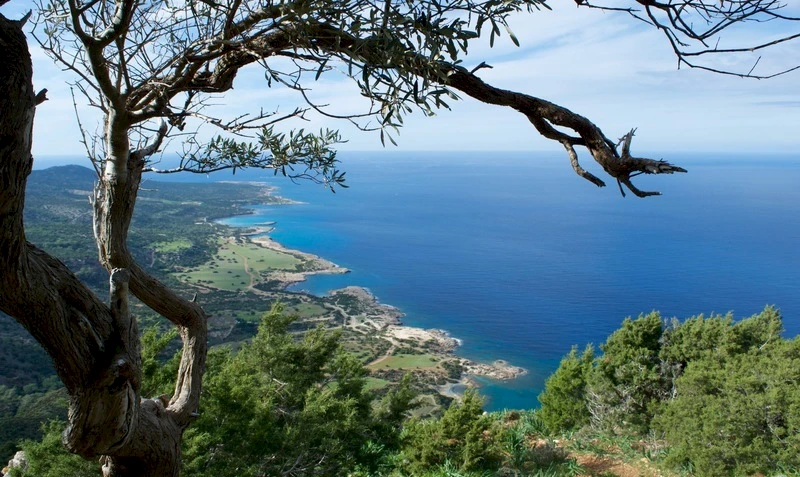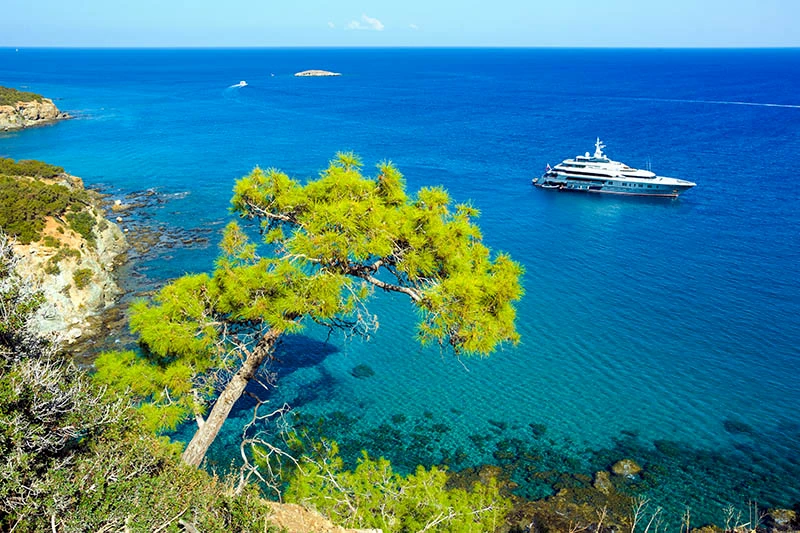Akamas National Park in Cyprus
This is the largest and most diverse national park in Cyprus, occupying almost an entire peninsula.
Akamas is a unique corner of Cyprus' wilderness, preserving its pristine nature and rich biodiversity. At the same time, it offers all the necessary infrastructure for modern tourists. Visitors can find guesthouses, restaurants, traditional villages, and eco-tourism opportunities. Despite tourism development, the region maintains its natural integrity and carefully preserves its historical heritage.

Akamas Peninsula in Cyprus
The Akamas Peninsula is located in the northwestern part of Cyprus. It is an almost untouched natural area with breathtaking landscapes, diverse flora and fauna, clean beaches, and rich historical heritage. The park is popular among hiking enthusiasts, cyclists, divers, and photography tour participants.
History of Akamas
The peninsula's name is linked to the ancient Greek hero Akamas, son of Theseus. Archaeological findings indicate that the area has been inhabited since the Neolithic period (around 10,000 BC). During the Bronze Age, Mycenaean settlements existed here, and in the 4th century BC, significant historical events took place in western Cyprus, leading to the founding of Nea Paphos and Arsinoe. Remains of an ancient necropolis have been discovered at Cape Drepanon.
Flora of the Akamas Peninsula
Akamas is part of the Natura 2000 network—a collection of specially protected areas in the European Union. The landscape includes pine and juniper forests, shrublands, pastures, and coastal vegetation. Over 600 plant species have been recorded in the park, including rare and endemic species such as the Cyprus cyclamen, sea daffodil, and Cyprus poppy.
Fauna of the Akamas Peninsula
The peninsula is home to numerous animal species. Among mammals, foxes, hares, hedgehogs, and bats are common, including the rare Egyptian fruit bat—the largest bat in Cyprus, with a wingspan of about 60 cm. This species has a wide range in Africa and Southwest Asia, and Cyprus is the only European country where it is found.
Reptiles
Reptiles in the park include chameleons, Cyprus’s largest lizard—the star agama—and Schreiber’s fringe-fingered lizard, which is listed in the Red Data Book. The Troodos lizard, an endemic species of Cyprus, is also found in the region, mainly in forested areas.
Snakes
Six out of the eight snake species in Cyprus inhabit Akamas. Three of them are venomous, but only the blunt-nosed viper poses a real danger. It may attack if disturbed, so for safety, avoid approaching any snakes. In case of a bite, seek medical attention immediately. The whipsnake is also common in Akamas; it is the longest snake in Cyprus, reaching up to 3 meters, but it is harmless as it has no venom.
Insects
If you are lucky, you may spot rare species such as the praying mantis or owl fly. The endemic butterfly Glaucopsyche paphos is quite common, while Apharitis acamas is rare both in Akamas and in the rest of Cyprus.
Europe's largest dragonfly, the magnificent emperor (Anax immaculifrons), with a body length of up to 9 cm, can also be found here. Its primary range is in Asia, with small populations in Cyprus and some Greek islands. In Akamas, it is mainly seen in the Avakas Gorge.
Marine Fauna
The sea around Akamas is home to rare species of fish, crabs, octopuses, and sea urchins. Common fish species include red mullet, Mediterranean moray eel, and dusky grouper.
A particularly valuable feature of the region is the beaches where green and loggerhead sea turtles lay their eggs. The protected Lara-Toxeftra area plays a crucial role as a nesting site for these turtles. Each year, around 100 green turtles and 300 loggerhead turtles lay eggs here, with an estimated 25,000–30,000 hatchlings born annually.
Trekking on the Akamas Peninsula
The park is popular among hikers and nature lovers. Well-marked trails with signs and rest areas are available. Popular routes include:
-
The Aphrodite Trail, leading to the Baths of Aphrodite and a panoramic viewpoint.
-
Avakas Gorge—a picturesque canyon with steep cliffs.
-
The route to Cape Arnautis, passing wild beaches and rocky cliffs.

Frequently Asked Questions about Akamas
Is swimming allowed in Akamas Park?
Yes, you can swim in the bays and beaches along the coast. However, there are no facilities, even in the popular Blue Lagoon. Visitors must take their trash with them to the nearest bin.
Is there an entrance fee for the park?
Entry to the national park is free, but guided tours, buggy, quad bike, or boat rentals require payment.
Can you stay overnight in the park?
Camping is prohibited within the park, but there are campsites and hotels in nearby villages such as Latchi and Neo Chorio.
When is the best time to visit Akamas?
The best seasons are spring (March–May) and autumn (September–November), when the weather is pleasant and nature is at its most beautiful. Summers can be extremely hot, making hiking challenging.
Are there restaurants and cafés in the park?
There are no cafés in the park, but restaurants and taverns can be found in nearby villages like Latchi and Neo Chorio.
How can I get to Akamas Park?
The peninsula is quite remote from popular tourist spots, so driving is the most convenient option. However, public transport is available.
By Bus
Bus No. 622 runs from Polis to the Baths of Aphrodite—the only public transport route to Akamas. There is no direct bus from Paphos, but you can first take Bus No. 610 to Polis.
By Taxi and Transfers
Taxis are expensive, and return trips are not guaranteed unless pre-arranged with the same driver.
